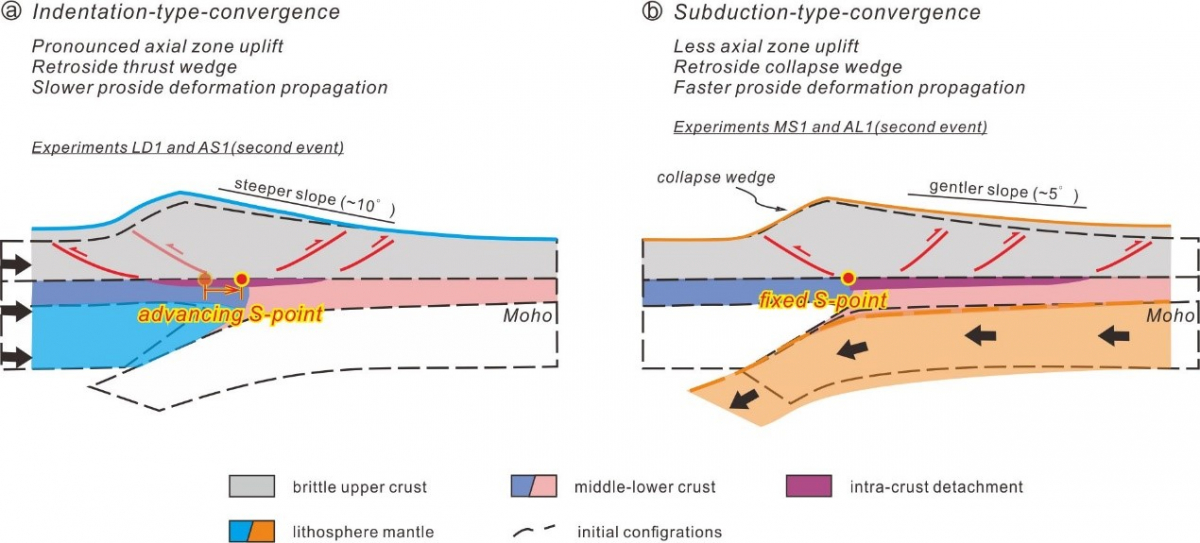Professor Zheng Wenjun’s team Identified the contribution of mantle subduction during the growth of NE Tibet
Source: School of Earth Sciences and Engineering
Edited by:
Formation process of large intraplate deforming belts, such as the edges of Tibetan Plateau and high mountain ranges in Central Asia is somehow mystic based on traditional theory of plate tectonics. Under this theory, it is difficult to explain how deformation takes place and is sustained in the continental interior. Two end-member geodynamic modes therefore have been proposed to decipher the driven forces of intraplate orogenesis. One mode considers enough plate boundary force being transferred into the deep interior of continent. Presence of high-strength or rigid block (i.e., indenter) can greatly enhance the force transition, therefore the related framework is usually called indentation tectonics (Figure 1A). The other one suggests that mantle of continental lithosphere can subduct like oceanic plate once the buoyancy upper-middle crust has been scrapped off (Figure 1B). In this subduction-related case, a basal drag originated from the subducting mantle drives the shallower crust to pile and form intraplate orogens. These end-member modes may operate simultaneously or alternately during the evolution of one orogen. However, whether they have distinct effects on the style of resultant orogenic architecture remain unclear, making their identification difficult and sometimes dispute. The northeast margin of Tibetan plateau is one of the typical examples.

Figure 1. Sketches illustrating typical features of each convergence-mode-dependent deformation.
This contribution presents sandbox experiments simulating the orogens evolving under convergence modes that correspond to the end-member geodynamics. The architecture of modeled orogen is analyzed to obtain high-resolution perspective on the shallow fault styles, seismicity, and uplift patterns that can directly be observed in the field. The results reveal that: indentation-type convergence promotes deformation propagation toward the overriding plate and will result in a doubly vergent orogen in the final mature stage (Figure 1A); Whereas mantle-subduction-type convergence enhances orogen expansion above the subducting plate only, thus single vergent orogenic wedge persists (Figure 1B). Such contrast is a reflection of distinct deformation partition modes determined by the applied convergence. The indenting block localizes more deformation in its front, producing a fast-uplift axial zone that can reach the critical height required for overriding plate deformation (McClay and Whitehouse, 2004). In comparison, the axial zone above the subducting plate uplifts slowly, and more deformation is transferred into the subducting plate. Notably, lower axial zone here additionally determines a small topographic relief.

Figure 2. Particle Image Velocimetry analysis on selected snapshots of BC1, showing temporal deformation localization. The left column shows colored horizontal displacement with flow lines, which represent temporal motion tendency of the materials within the model. Red arrows mark the location of rapid uplifting. The right column shows incremental uplift (vertical displacement).
The presented modeling also shows that changes of convergence mode leave distinct structural relics. Out-of-sequence faulting occurs when indentation-type convergence replaces the mantle-subduction-type mode. Conversely, the overprinting of mantle subduction on an earlier indentation mode triggers immediate in-sequence, foreland-propagating thrusting. Furthermore, a bi-directional convergence involving opposite-direction indentation and mantle-subduction has created a special deformation configuration, in which incremental deformation is partitioned on the edges of orogen but with a quiescent axial zone (Figures 2b&d). This feature is consistent with the distribution of present-day seismicity (Figure 3e) observed in the active Qilian Shan fold-thrust (northern Tibetan Plateau), confirming a bi-directional compression state during its recent evolution (Figure 3). The comparable orogenic architecture and fault sequence in the modeling and nature further suggest that mantle subduction has lowered the surface slope of Qilian Shan by accelerating lateral deformation propagation.

Figure 3. (a-b) Location of the Qaidam-Qilian thrust belt in northern Tibetan Plateau. (c)Swath profile (80 km-wide) across the Qaidam-Qilian region shows regional topo-graphic relief with regional surface slopes indicated. Notably, local relief around the transition zone between NQL and HCB is not considered here. The profile coverage is indicated by green rectangular box in Fig. b.(d) Cenozoic rapid exhumation ages obtained around and in the same swath profile shown in Fig. b. The dashed arrows outline a hypothetical Cenozoic deformation sequence according to our sandbox experiments. (e)Structural cross-section of the northern Tibetan Plateau. Earthquakes (from CSN 1990-2017) within the swath profile of Fig.10b are projected as well. NQTB and QLS are considered as the bounded faults of axial zone in the Cenozoic Qilian Shan thrust wedge. Lithospheric structure from Gao et al. (1999), crust structure from Yin et al. (2008). Yellow dash line in bold is the inferred along-dip geometry of Qilian su-ture (QLS). Its map view extension is also marked on Fig.10b after Zuza et al. (2016). ATF: Altyn Tagh Fault; KLF: Kunlun fault; HYF: Haiyuan fault; NQB: northern Qaidam Basin; S/C/NQL: southern/central/northern Qilian Shan; HCB: Hexi Corridor Basin; HLL: Hala Lake; QHL: Qinghai Lake.
Journal: Earth and Planetary Science Letters
Link to the paper: https://doi.org/10.1016/j.epsl.2022.117476


